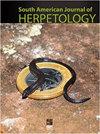Variations in Oocyte Maturation and Lysis of the Common Toad Rhinella arenarum (Anura: Bufonidae): Is Climate Change Affecting Oocyte Functionality?
IF 0.7
4区 生物学
Q4 ZOOLOGY
引用次数: 0
Abstract
Abstract. Many recent studies have shown that amphibian populations have been affected by a variety of causes including climate change, pollution, habitat destruction, and disease. Such drivers could also influence the physiological and behavioral reproductive events of individuals. Rhinella arenarum is an amphibian species that has been extensively used as an experimental model for biological studies. This is an ecologically important species due to its abundance and wide distribution in South America. Our research on the female gonad of R. arenarum conducted in the last three decades has allowed us to observe that the competence of the ovary of this species has been slowly modified over the years, manifested by an increase in oocyte lysis during in vitro assays. To better understand the changes, a retrospective analysis of data from the last three decades was performed in order to quantify oocyte maturation and lysis in the presence of different incubation mediums. Data from three sampling years (1993, 2005, and 2018) were selected, and percentages of oocyte maturation and lysis were compared. Results show a significant decrease in oocyte maturation and an increase in oocyte lysis in the last sampling year. We also examined the climate conditions of the habitat of R. arenarum in each sampling year and their variation as a possible driver of decreased ovarian functionality. A significant increase in minimum temperatures, solar radiation, and relative humidity is reported. Alterations in the climate conditions of the natural habitat of R. arenarum might be one of many factors responsible for the decrease in ovarian functionality. Further analysis of the impact of the ongoing climate change on several aspects of amphibian phenology is needed to strengthen understanding of population declines and promote species conservation.普通蟾蜍(无尾目:蟾蜍科)卵母细胞成熟和裂解的变化:气候变化是否影响卵母细胞功能?
摘要最近的许多研究表明,两栖动物种群受到多种原因的影响,包括气候变化、污染、栖息地破坏和疾病。这种驱动因素也可能影响个体的生理和行为生殖事件。竞技场犀牛是一种两栖动物,已被广泛用作生物学研究的实验模型。由于其在南美洲的丰富和广泛分布,这是一个具有重要生态意义的物种。在过去的三十年里,我们对竞技场蛙雌性性腺的研究使我们能够观察到,多年来,该物种的卵巢能力发生了缓慢的变化,表现为体外试验中卵母细胞裂解的增加。为了更好地了解这些变化,对过去三十年的数据进行了回顾性分析,以量化在不同培养基存在下卵母细胞的成熟和裂解。选取三个采样年(1993年、2005年和2018年)的数据,比较卵母细胞成熟和裂解的百分比。结果显示,在最后一个采样年,卵母细胞成熟度显著下降,卵母细胞核溶解增加。我们还研究了每个采样年沙蚕栖息地的气候条件及其变化,这可能是卵巢功能下降的驱动因素。据报道,最低温度、太阳辐射和相对湿度显著增加。arenarum自然栖息地气候条件的变化可能是导致卵巢功能下降的众多因素之一。需要进一步分析持续的气候变化对两栖动物表型几个方面的影响,以加强对种群减少的了解,促进物种保护。
本文章由计算机程序翻译,如有差异,请以英文原文为准。
求助全文
约1分钟内获得全文
求助全文
来源期刊
CiteScore
1.50
自引率
0.00%
发文量
10
期刊介绍:
The South American Journal of Herpetology (SAJH) is an international journal published by the Brazilian Society of Herpetology that aims to provide an effective medium of communication for the international herpetological community. SAJH publishes peer-reviewed original contributions on all subjects related to the biology of amphibians and reptiles, including descriptive, comparative, inferential, and experimental studies and taxa from anywhere in the world, as well as theoretical studies that explore principles and methods.

 求助内容:
求助内容: 应助结果提醒方式:
应助结果提醒方式:


